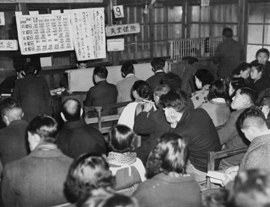
With the decline of the special procurement boom, employment offices saw an increased demand for jobs by men and women. Photo from 1952.
Photo from Mainichi Shimbun.
Tokuju (Special Order) Boom and Female Workers
In response to the outbreak of the Korean War in 1950, The U.S. military ordered a large number of products, such as textiles, from Japanese firms. The business from the U. S. brought Japan a period of economic growth called the Special Order (Tokuju) Boom. Since the textile industry and the metal industry were especially prosperous, people also referred this economic boom as "Itohen (thread-related) Boom" and "Kanehen (metal-related) Boom." The demand for labor rapidly increased, and many women worked as factory workers in the textile industry, repeating the pattern of the early decades of the twentieth century, when women in the textile industry contributed heavily to Japan’s industrialization. However, the textile industry declined as the Korean War ended, and there were mass layoffs of female workers in the industry.
|

